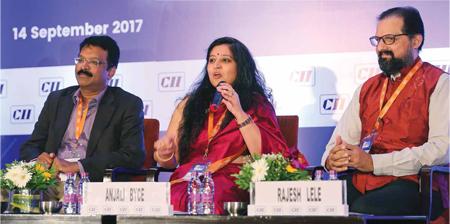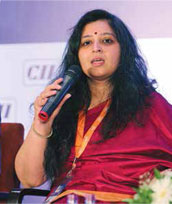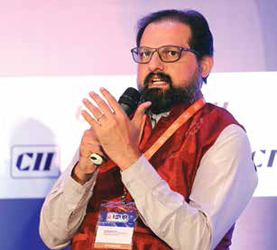With the change in organisation structures in the new environment, what’s going to happen to the capabilities that are going to become hot skills and how is all these going to impact in terms of career paths? This was the topic of one of the panel discussion, at the recently- concluded Confederation of Indian Industry (CII) HR & IR Conclave 'HRevolution', held at Hyatt Regency, in Pune. The topic discussed was Organisation structure and Career path and the panellists were K. Sitaram, Director - Human Resources, GE Supply Chain - South Asia, GE India Industrial Private Ltd; Anjali Byce, Convenor, CII Pune HR & IR Panel & Director-Human Resources, SKF India Ltd (Moderator) and Rajesh Lele, General Manager and Head eHR, Tata Motors Ltd. Corporate Citizen brings you the excerpts of the discussion
Oftentimes when we are talking about organisations wanting to drive accountability or trying to drive quick decision making, trying to drive empowerment and behaviours like this, we leave a lot of reward behaviours, said Anjali Byce starting the discussion. It is a very powerful example of how you use organisation structure to drive a customer-centric organisation that drives behaviours that are really going to deliver the business. "We have been hearing how Tata Motors went through this beautiful attempt to look at reorganising—a very bold step of the organisation with such a large and old legacy, to crash down the number of designations and structures in the organisation. You step back and look at something forward, it takes a lot of courage," she said.
 K Sitaram, Director - HR, GE Supply Chain – South Asia, GE India Industrial; Anjali Byce, Director-HR, SKF India and Rajesh Lele, General Manager and Head eHR, Tata Motors
K Sitaram, Director - HR, GE Supply Chain – South Asia, GE India Industrial; Anjali Byce, Director-HR, SKF India and Rajesh Lele, General Manager and Head eHR, Tata MotorsRajesh Lele: The background to this is the automotive industry—everybody would realise is a capital intensive industry—product development, in that sense, is a multi-year effort, and products last a long time. So, you may end up servicing trucks, which may have actually built a decade back or more. A lot of that has been organically grown in the Indian scenario. What’s changed over the last four-five years is, first and foremost, the product lifecycle got shorter, therefore the ability of the organisation to be far more fluid with the approach that we take for product development launch and sales and service, from the line and across the value chain, has to come down significantly and be speeded up significantly.
The second aspect, one which we are all faced with, is technology. Today, the automation component in each of our vehicles, could range anywhere from 20 to 60 per cent, and we are on the cusp of seeing driverless cars, where most automotive organisations and even non-automotive organisations are moving towards. That technology driver, is the second driver which is kind of pushing the automobile industry, in the last four-five years. Coupled with that is the regulatory dimension, with things like BS3, BS4 and the norms around emissions and so on, which constantly call for us to change the specs and dimensions of our product.
In middle of all of that, an organisation which was kind of growing organically, was faced with certain challenges and we realised that the way we were set up did not really give the flexibility and agility that we needed to be effective in the marketplace. And that’s the genesis or one of the key principles that we have, when we embarked on these changes.
 Anjali Byce
Anjali ByceWhen new mission, vision, values statement were rolled up recently, coupled with that were key components in terms of structure and performance system—it’s not just about the structure, but it’s actually about how people should behave within that structure, how people will interact with each other within that structure, and what is the value system that we have. As you mentioned that we have a legacy, so therefore we definitely expect internally and externally, to have a certain set of norms and values. So, all of that was kind of looked at and that’s been the genesis of our journey.
We relooked the way we were set up from a structural standpoint. We did some changes in terms of making the businesses a lot more resourced and agile. So, the business units themselves now are more empowered, better set up, therefore to be able to decide how they want to go ahead, with the kind of products that they have. And therefore the product management accountability was put within the business units themselves. That’s one of the key changes that we brought about. Earlier, conceiving the product was one part of the organisation, design was the other part, the manufacturing was the third part and sales and service, etc. was the fourth part. Here what we are saying is, we are putting everything within the organisation, within the business unit and saying that you make it from the conception to market and then even beyond. So, what is the lifecycle of the product, is also within that business unit itself.
So, that was one of the key principles-the flexibility, the agility that the business unit needed and the flip side of the coin therefore it brings in accountability. You have the accountability of the delivery of results, whether it is sales, market share, revenue, margins—all of that accountability now rests with the business. And as a result of that, the other dimension was the technology and therefore to keep pace with the industry, to keep pace with the technology, we needed nimbleness and agility, and that’s the third pillar we set-we really need this approach. So, that’s been the genesis, that’s been the kind of shift, in terms of why we did it, what we did.
"Organisations wanting to drive accountability, quick decision making, empowerment-we leave a lot of reward behaviours. It is a very powerful example of how you use organisation structure to drive a customer-centric organisation that drives behaviours that are really going to deliver the business"
- Anjali Byce
K. Sitaram: There is a huge amount of change happening across the organisation now. Simple thing, customer is not ready to pay for nonvalue, so any thing which is not having value to a product, customer is not interested to pay. So, those structures have to go. So, huge amount of structural changes are happening. We are more talking about customer-centric, mission based themes, result-based themes. So, go after the market, change the deal. First, get the deal and then do the back working, do the working so that you make money. It’s entirely different from the traditional way of working.
Sitaram: One of the biggest competencies that is coming into play is adaptability. What I am doing yesterday is not what I am doing today. And change is happening at such a fast pace that companies don’t have time to even think. We don’t even have time to figure out what is the new technology coming in. For example, we were always talking about improving efficiency, improving productivity, bringing advance machines and so on—suddenly you start hearing something called 3D printing, additive manufacturing, that’s going to rewrite the whole factory set-up, you will be no more having huge machines—and its catching up fast. So, we need to have people, who can adapt. So, adaptability is the key competency which will come. You cannot say, I have never done this before, so I will not it do now.
Lele: In my view, the key area would be critical thinking—questioning why we do what we do. From a competency and capability point of view, is it actually adding value to my organisation, or why am I doing this? That’s one of the areas where competency would be necessary. Technology is the other area where competency is needed—how do we adapt to that? Again, from the regulatory point of view, how do those regulations affect the setup that we have? How does it affect the way we manufacture? Not just our processes but the core technologies that we use and how do that change. The other change we would have to deal with is the way our business model is changing. The consumption patterns, especially in the passenger vehicles, have changed. The business model and consumption patterns are changing and therefore how do we get the frontline people to be able to sell in this kind of environment? Also, where cargo-sharing and load-sharing, etc., is slowly becoming a reality, driverless trucks that deliver cargo are reality today in the West and will take some time to come here—in the line of that how to make our frontline sales people effective, is another question we also have to deal with.
I don’t think we can divorce critical thinking and analytical skills, etc. from the leadership anymore. When we talk about leadership, it must include all of these things, otherwise it is not leadership in the new world.
"We relooked the way we were set up from a structure standpoint, did some changes in terms of making the businesses a lot more resourced and agile. The business units themselves now are more empowered, better set up, to be able to decide how they want to go ahead"
- Rajesh Lele
 K Sitaram
K SitaramSitaram: Most of our career has been about dealing with unions. I am yet to come across an HR professional, who says, “My union is very easy to handle”. Any union, any company, is very tough, aggressive, hostile, etc. So, whenever you do management discussion, all the management discussion endsup establishing that it is the management’s responsibility to run a factory and union or workmen are only there to stop the work or shut down the factory. But in reality, all the management staff, for their qualification and experience, if the factory shuts down, they may find some or the other job, but most of the workmen don’t find one. So, who should have more responsibility to run a factory? Look at union side—when the union comes and negotiates with you, 90% of the time the conversation is about the supervisor. That the supervisor is biased, that he did not give leave, he put me in the wrong shift, etc. So, all your energy gets sucked there. From the employee perspective, why do employees want to form a union? You have taken an employee, putting him as a contract labour for five years, without a salary increase. How many of us would be interested to work in a factory, where there is no salary increase, if there is no salary increase for five years. The day you become an employee, you want increase all the five years from the industry.
So, what we have done is, we have changed the whole paradigm—we said, we will not have any supervision of the factory. We have a factory with 600 operators— if you ask the operator which department he works, he will say he is from machining, or warehouse, or quality—we also wanted to break it. All the factory is divided into teams, based on the customer product and these teams, as there are no supervisors, all the team members are workers. I have 33 HR managers, each HR manager takes care of his team. Once a month I have a session with all these HR managers—they do what I do, for their team. They plan their training, they plan their career aspiration, they do their engagement initiatives, they are responsible for everything. And these positions are not permanent, like no one can claim that I am team captain for life. So, every 18 months there is mandatory relocation— the team has to sit and select themselves. So, they get multi-skilled. How it works? The team meets in the morning, they decide what to produce, and how to resolve issues.
There is something called open board communication system—either the team is capable of solving, then they should solve and work and if the team is not capable of solving, they have to just go and write on the board. All of the leadership team have been instructed not to interfere. They do better when we don’t interfere. All of us have been instructed not to be part of their meetings. Their only job is to go and have a look at the board. So, they are to the fore, they get customer feedback. It’s been going well for five years, it is not easy—we still have traditional people in the company, who keep pulling it back. In a traditional company you have supervisors, the ratio is one to ten, so we may end up having 60 supervisors on the shop floor and to manage those supervisors we have another four managers. So, the salary of 65 people, customer is not going to pay. We diverted that cost of 65 people to workers. We put education, free time, they manage the show. So, that’s the structureless shop floor.
 Rajesh Lele
Rajesh LeleLele: Definitely we have taken a multi-prone approach. One is, in the new structure, people have to live and work within the structure. It is the second layer of exercise which is the job evaluation exercise which has been done as a result of that and people will be given specific job descriptions in terms of what are their expected outcomes from them in the new organisation structure. Secondly, there is lot of training that we have done over the last year and we continue to do that in terms of people management. Because, ultimately there are people that will live out that structure and to that extent we have been training managers and we have been training people, to be able to handle people better within the structure, in the context of their new roles and responsibilities. So, even when the new structure was announced, it was not just mass emailer. There were clear and strategically structured workshops, which were done at different levels within the organisation. The leaders of the different businesses were present and the rational and why things were done the way they were done, was presented to them. So, there is a lot of time, effort and investment, which is going into helping people understand that how structure should be lived up to. That’s one clear strategy that was taken and of course, since this all is relatively new, we will see the proof, in may be a few months or years to come, as to how this is working out and then take a call.
Sitaram: Whenever you bring change, there is a resistance. Because 100 per cent of the people will never buy in the change that you want to bring in. Every change brings some amount of pain and shaking. All the people who were sitting comfortably, you are pushing them to be uncomfortable and every uncomfort brings lot of noise. What happens in any change intervention is, people who are accepting change, who have embraced change, they move on. People who have not embraced change, they are the people who are very noisy, they make huge amount of noise in the system that the whole process gets failed. So, what we teach is don’t aim for perfection. Especially when you are doing people change, don’t aim perfection.
How are we involving people? They are part of the change, they are part of the design, acceptance is very high. We got an objective, but how to do, where to do, when to do, is always designed by the people who get impacted. That’s how change is tough but it’s not impossible.
"One of the biggest competencies that is coming into play is adaptability. What I was doing yesterday is not what I am doing today. And change is happening at such a fast pace that companies don’t have time to even think. or figure out what is the new technology coming in"
- K Sitaram
Lele: The approach that we took was, to a certain extent, to establish a small team that was responsible for this transition and lot of communication that went on—lot of training for the managers and leaders, that also helped in terms of at least in understanding and acceptance. And in some areas where we have to hold back, we listened and we did kind of rolled back in one or two areas that didn’t go well with people. So, yes it has been a kind of interactive process, but that’s the reality.
Sitaram: It was not the operators who were tough, managers were tougher to handle. They had many questions, they didn’ t believe that this will work. They didn't want to let go. So, we did lot of training to the managers that this is value adding. Forcefully, what we have done is we have removed few people from the system, kept them out of the shop floor. We brought in lot of transparency. It was relatively easy for the shop floor. The moment we let them, they embraced, they took over, they showed double the energy to ensure that they are successful.
By Rajesh Rao